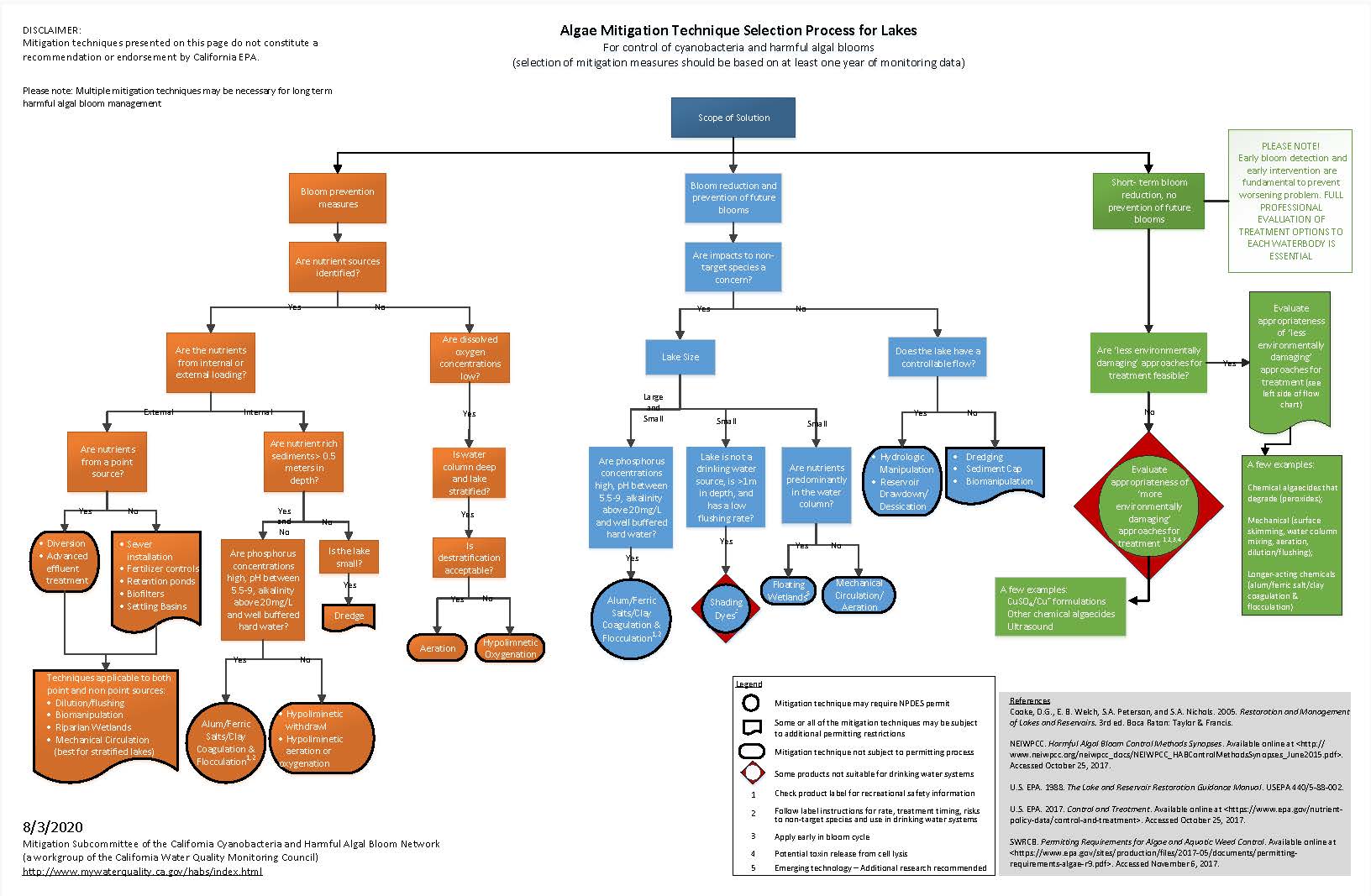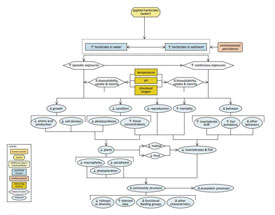Resources for Mitigating HABs
Introduction to Selecting a Mitigation Strategy

Numerous methods for managing and mitigating algae and CyanoHAB blooms in lakes and reservoirs are included in the following flowchart.  The flowchart highlights important elements and decision points leading to the selection of mitigation methods relevant to the characteristics of specific lakes. The flowchart is a simplification but clearly illustrates the complexity of the problems associated with making effective mitigation decisions. Frequently, multiple mitigation techniques and repeated applications are required to ensure and maintain success.
The flowchart highlights important elements and decision points leading to the selection of mitigation methods relevant to the characteristics of specific lakes. The flowchart is a simplification but clearly illustrates the complexity of the problems associated with making effective mitigation decisions. Frequently, multiple mitigation techniques and repeated applications are required to ensure and maintain success.
The flowchart is divided into three primary categories:
- Bloom prevention,
- Bloom reduction and prevention of future blooms, and
- Bloom reduction with no prevention of future blooms.
Cautions for Chemical Use
 Flowchart category (3) typically relies on the application of algaecides to quickly stop or reduce a specific nuisance bloom. Permits are required for algaecide use – see presentation and weed control permit webpage. Algaecides are sometimes critically needed in a timely fashion to control specific problem blooms, e.g., in drinking water supplies. Algaecides do nothing to address root causes or prevent future CyanoHAB events and if improperly used can seriously affect non-target species and food web, as illustrated on the following flowchart.
Flowchart category (3) typically relies on the application of algaecides to quickly stop or reduce a specific nuisance bloom. Permits are required for algaecide use – see presentation and weed control permit webpage. Algaecides are sometimes critically needed in a timely fashion to control specific problem blooms, e.g., in drinking water supplies. Algaecides do nothing to address root causes or prevent future CyanoHAB events and if improperly used can seriously affect non-target species and food web, as illustrated on the following flowchart.
A particularly concerning impact to non-target species of algaecides applied to a massive bloom is the potential for rapid die-off of the bloom to cause depletion of dissolved oxygen and consequently a massive fish kill. Whether a fish die-off occurs is related to the size of the algal bloom, the rapidity of the algal bloom decline, the depth and volume of water in the lake, and other factors. Chemical treatments can be very effective at controlling the size of algal blooms and should be carried out at an early stage in the bloom—before algal biomass reaches a critical level—to avoid rapid oxygen depletion and fish kills in treated lakes. (Fish kills can also happen due to natural die-off of blooms that cause rapid oxygen depletion.) This requires an appropriate and routine monitoring program (see Resources section below) that can detect a bloom early in its development. It also requires a system in place and ready to implement to respond to the detection.
Algaecides may also result in the release of toxins contained in cells into the water, making them more problematic to remove during drinking water treatment, and having potential adverse ecological impacts.

Moreover, the release of toxins may also impact cultural uses. Tribes and Tribal communities who engage in traditional water uses such as gathering, ceremonies, navigation, subsistence consumption and other intrinsic uses of waters within their ancestral territories are often bound to both location and timeframe for these activities, as practiced by their families and ancestors before them.
Prior to any algaecide treatments on a waterbody, waterbody managers should engage local Tribes and their Regional Water Board to determine the best course of action to protect Tribal cultural uses and mitigate for any increased lysing of cyanobacteria cells that would increase exposure to cyanotoxins during Tribal cultural uses. Herbicide and algaecide treatments should always avoid locations and times that could create impacts on Tribal cultural uses and users.
Flowchart categories (1) and (2) may rely on the application of other chemicals. For example, aluminum sulfate (alum) is used to coagulate and flocculate phosphorus to sequester it in bottom sediments. If lake water buffering capacity is insufficient, then chemical buffering agents must be used to avoid drops in pH that can be toxic to fish.

Addressing the Root Cause
Flowchart categories (1) and (2) are more focused on addressing the root causes of the blooms through nutrient management using a wide variety of approaches. Both categories have many management options in common. The primary driver of CyanoHAB blooms are nutrients, with phosphorus being widely recognized as the most important nutrient, but certainly not the only one.
In-depth Understanding of Nutrient Sources and Dynamics
It is critical to understand the sources and dynamics of nutrients in problem lakes prior to selecting mitigation strategies, see Nutrients Dynamics Document. Selection of mitigation measures should be based on at least one year of monitoring data and a basic understanding of the characteristics unique to your lake, including its basic hydrology. Although the same processes are at work in most lakes and reservoirs, the relative importance of individual processes are dependent upon many factors including lake and watershed morphometry, land use, hydrodynamics, nutrient sources, and many other factors. Each lake is unique with its own “personality” and history. The task is to understand it sufficiently to make informed management decisions.
Resources for Lake Managers and the General Public
The following resources are organized to systematically direct lake managers and the general public to information useful for understanding applicable limnology principles, management techniques, mitigation strategies, permitting requirements, and to pertinent professional societies.
- Preliminary Lake Evaluations (PLE) for Managing Cyanobacteria and Harmful Algae
- Overview of PLEs
- Instructions for Lake Managers
- Example: Willow Lake (Plumas County) Lassen National Forest
- Limnology Principles – Comprehensive Resources
- Cooke, D.G., E. B. Welch, S.A. Peterson, and S.A. Nichols. 2005. Restoration and Management of Lakes and Reservoirs. 3rd ed. Boca Raton: Taylor & Francis
- Water on the Web: Lake Ecology Study Unit
- 2017 3-day U.S. EPA Region 9 HABs In-Person Workshop; Numerous presentations on all aspects of CyanoHAB management, April 25-27, 2017
- Management Techniques and Mitigation Strategies
- U.S. EPA. 1990. 2nd Edition. Lake and Reservoir Restoration Guidance Manual. USEPA 440/4-90-006
- U.S. EPA.
- New England Interstate Water Pollution Control Commission (NEIWPCC). Harmful Algal Bloom Control Methods Synopses
- Washington state: Algae Control Methods
- The Practical Guide to Lake Management in Massachusetts
- 2017 Literature review prepared for Mitigation Subcommittee: Freshwater Harmful Algal Bloom Mitigation Report: Hypolimnetic Oxygenation, Alum Treatment, and Phoslock®, by Matt Gargiulo, M.S. student at UCSB Bren School
- Permitting Requirements
- California Water Board weed control (algaecide) permit website
- [Note for Lahontan Regional Water Board – first need exemption from prohibition against discharge of pesticides into water]
- Presentation on California Statewide general permit for algaecides
- California Water Board weed control (algaecide) permit website
- New York State has developed HAB Action Plans for twelve priority lakes and has many helpful resources – here are two:
- Action Plans overview
- Book: Diet for a Small Lake: The Expanded Guide to New York State Lake and Watershed Management is a compendium of information about the ecology, monitoring, and management of lakes and watersheds throughout New York State, drawing from the vast experience of many state lake management experts. This guide is written for both lake residents and professionals; the book includes numerous case studies and examples from New York state lakes.
- Florida has posted information on freshwater harmful algal blooms . Relatively recently,Florida established a grant program to help combat freshwater algal blooms caused by Lake Okeechobee water discharges . Unfortunately, as also described on their webpage, along its Gulf coast Florida also suffers from “red tide” problems.
- Watershed Options – Best Management Practices
- Best Management Practices for Reducing Discharges of Nutrients – Total Maximum Daily Loads (TMDLs)
- Regional Water Boards have established some regulations called TMDLs to reduce the amount of nutrients discharged, especially for discharges into eutrophic waters. TMDLs often rely on and describe in detail “best management practices” to reduce discharges of nutrients. California TMDLs are listed at the TMDL Program Webpage. Search for “Nutrients” and “Nitrogen”; Additionally, TMDLs for dissolved oxygen, sediment, and some other pollutants may also reduce eutrophication.
- Shoreline Property – Actions Locals Can Take
- Snohomish County, Washington: Your lake needs your help to stay healthy. Find out small changes you can make on your property to protect your lake and be LakeWise. Click here for more information.
- Vermont: The Lake Wise Program is an Agency of Natural Resources initiative that awards lake-friendly shoreland property, including that of state parks, town beaches, private homes and businesses. Click here for more information.
- Best Management Practices for Reducing Discharges of Nutrients – Total Maximum Daily Loads (TMDLs)
- Join Professional Societies to Learn About More Resources
- California Lake Management Society – CALMS hosts an annual conference, distributes an annual newsletter, and more.
- North American Lake Management Society – NALMS hosts an annual conference, publishes a quarterly, peer reviewed journal “Lake and Reservoir Management,” publishes a quarterly magazine “LakeLine,” conducts a certified lake manager (CLM) program, and certified lake professional (CLP) program, and more.
- Aquatic Plant Management Society – APMS hosts an annual conference, publishes an annual peer reviewed journal, “Journal of Aquatic Plant Management,” distributes an annual newsletter, and more.
- Western Aquatic Plant Management Society – WAPMS hosts an annual conference, distributes an annual newsletter, and more.
- California academics may be a resource for mitigation
Mitigation Subcommittee Resources

